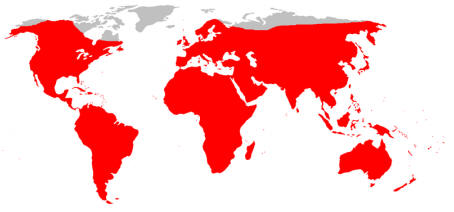Habitat
Habitat: Rattus
norvegicus is a very versatile species that can
adapt to harsh climates of the cold and heat.
For example, there was a study done in the Yukon
that actually analyzed the brown rat for the first
time in 2010. What is surprising is that
Alaska, bordered by the Yukon, has only had nine
recorded brown rats between 1951 and 2007. [6]
To express the adaptability of the Rattus norvegicus,
around this area of the world, summers can be as
warm as 90°F and as cold as -40°F in winter.
Permission for Use
![]()
This work is licensed under a Creative
Commons Attribution-Noncommerical-Share Alike 3.0
Unported License.
Rattus norvegicus that
inhabit areas of land away from buildings and
civilization prefer high levels of cover such as
scrub vegetation, overgrown ditch banks, hedgerows,
and fodder crops. They prefer any type of
cover as long as it obscures the vision of predators
from above. If the Rattus norvegicus was
living on a farm near animals and humans, it would
stay under and/or near debris in the machine shed.
There was a study performed that tested the home
range of brown rats that were in fields as compared
to machine sheds. Evidently, the conclusion
was that field rats traveled much more area for
living accustoms. This can be correlated to
the food supply available; brown rats could share
feed with the farm animals while field animals
journeyed out to suffice the demand of obtaining a
meal. In addition the survival rate was
significantly better for rats who remained close to
thicker areas of brush. [8]
 [8]
[8]
 [8]
[8]
As seen in the picture ,
brown rats were placed throughout various areas on
the farm. Some were near feeders and
buildings, others were out in the fields.
The top picture is representing 7 brown rats that
were tagged and tracked to study the distance
covered for the preferred habitat of each
individual rat. The bottom picture represents
the paths taken by 5 tagged rats while acquiring
food. This supported that any open areas were
disproved by the Rattus norvegicus. In
addition, the table below is showing the results of
survival for the different habitats that each trial
rat was placed in.
Previous to: Classification Next to: Adaptation

